TISCH IM RAUM/THE CAKE IN THE ROOM
drawing, dinner, dinner table, performance
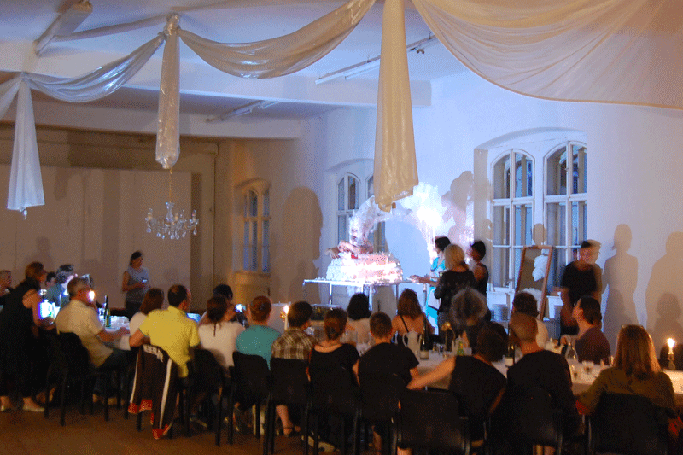
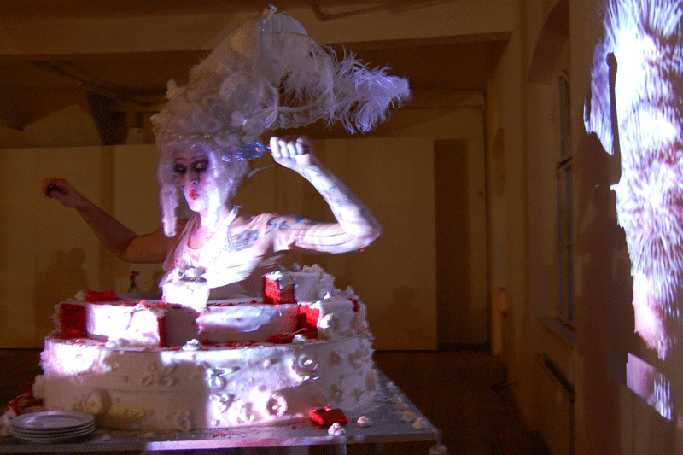





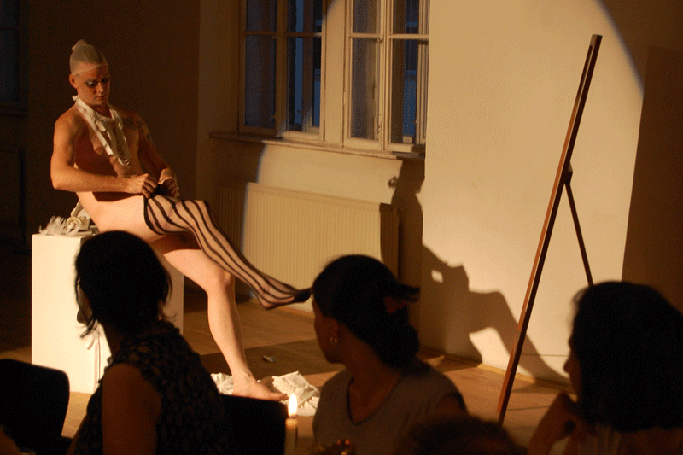




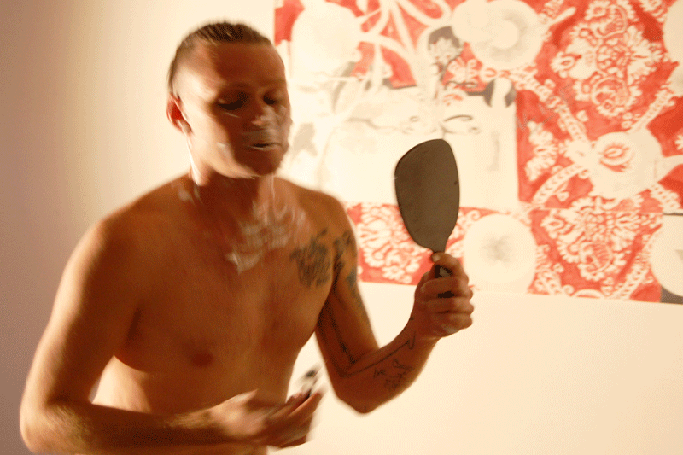




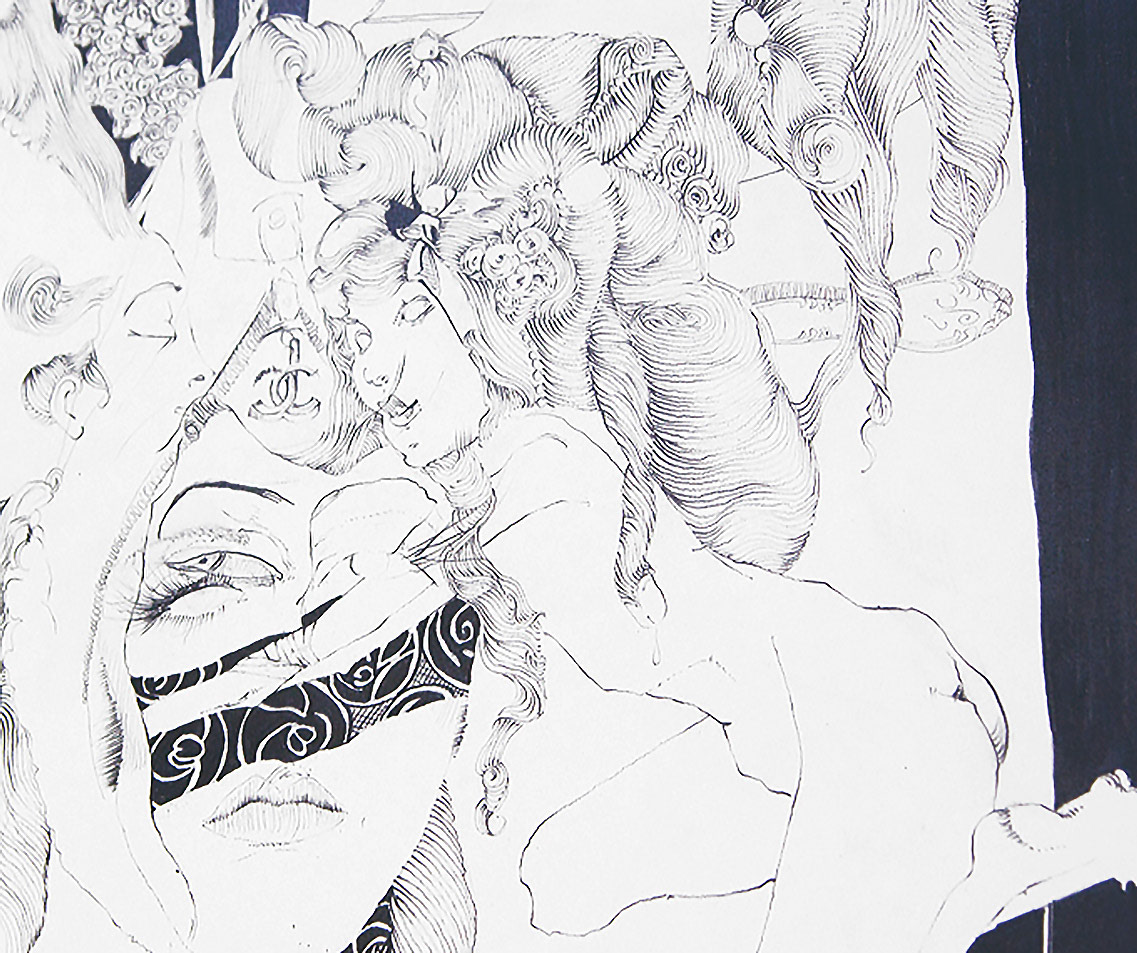



photos by Klaus Schafler, Songul Boyraz and Rachel Maki
Samuel Jablon of Bomb Magazine engages artistAaron Sheppard in a discussion about his new work the cake in the room, Alice in Wonderland, Jesus, and Miss Havisham.
This conversation began when I met Aaron Sheppard at an opening in Chelsea, and ended months later. In person as well as over email, we explored transformations and transitions from Jesus to Marie Antoinette for Aaron’s performance/dinner party, cake in the room partof the tisch im raum (table in the room) seriesat the Kunsthalle Exnergasse in Vienna, Austria.Aaron’s performance, which occurred in mid-July,highlighted stereotypes in physical appearance and explored the humanity hidden in the transitions between transformations. As Aaron went to Vienna and I left for Beijing, our conversation transitioned to a cross-continental dialogue, but ultimately wrapped it up much closer to home, both transformed by our travels, chatting over a beer back in New York.
Samuel Jablon- Could you tell me about your performance in Vienna?
Aaron Sheppard- tisch im raum (table in the room)is an ongoing project/tradition for Kunsthalle Exnergasse which involves presenting an artist’swork to 50 dinner guests seated at one long dinner table placed inside the gallery. Discussion of the art occurs around the table withthe artist either before or after the work has been viewed and food and wine have been consumed. Always a one-night event, the table and work remain on display for the duration of the exhibit, accompanied by video and audio of the dinner and discussion.
For my own show at KEX it interested me to embody or narrate elements in my drawings. I wanted to explore further, performatively, my specific fascinations with the Austrian artist/illustrator Franz von Bayros (whose line etchings I have been studying for the last few years, serendipitously), Sir John Tenniel, of Alice and Punch & Judy fame, as well as Max Ernst’s books of collage. I first created one large drawing. The drawing collages elements from the artists’ works mentioned into one 3'×15’ graphiteand red latex on paper work. Just as the table in the room is a meeting place for sustenance and ideas, my drawing represents this as well.The drawing is source for performance and formally acted as a backdrop to the performance. The shape of the drawing was bastardized/Americanized from the dimensions of the dinner table: 1 meter by 15 meters. Rather than occurring before or after the traditional dinner at the table in the room, I wanted the performance and actual work to BE the dinner, at which time transformations took place from myself into Jesus Christ into Miss Havisham/Edie Beale into Marie Antoinette into a Vegas vagabond, exposing my body as a malleable material or canvas—food and body, body and food for thought.
SJ- Could you expand on the transformation you went through during the performance?
AS- I was most concerned with the transformation in the beginning of the performance and spent the most time thinking about that. I wanted to create an unanticipated starting point so that I could more slowly change my viewers’ perceptions. I welcomed people to the dinner table after giving time for viewing the drawing on the wall. I began pouring wine around the table and personally addressing each guest as I moved.As I removed my clothing, individuals adjacent to me first realized then that the performance had begun. My original plan to recite Alice by Tom Waits, line-by-line, changed the minute the door was opened to the gallery space. I had an immediate and strong interaction with the guests and understood at that moment that we were all in for a more spontaneous and interactive evening. So my plan changed for the better, and became more intuitive since I was uncomfortable with transforming from myself into an actor(in my mind) by reciting something from memoryas a way to introduce what was to come into thefirst transition of the performance. Rather than what I somewhat anticipated (although I really had no idea what to expect), luring engagement was not a problem.
Once nude, I donned a robe and a crown of thornsas Jesus and at the dinner table toasted to Alice with slow outstretched arm gestures. Because a connection with guests had already beensomewhat established, a spontaneous decision toask each if they would like beard with their clam came about. (By this point the table had been served fresh oysters that had been shuckedby the chef in the same room.) With an electricrazor, I removed Jesus beard and other body haironto plates.
The change from Jesus into Miss Havisham turnedmore introvertive, ignoring the table completelyat times while shaving in a mirror, yet also invading guests on an individual basis when running to the table demanding assistance with the necklace or zip-up of the dress. Once completeas Havisham, my attention was directed toward the individuals at the table without attendingto the comfort of her guests but rather pushingon her guests her demands: excess of wine over-flowing, switching of plates, more/less food.
Marie Antoinette put on lingerie, again self-absorbed in the mirror. Behind a scrim Marie enters a table with cake as outfit and a plumedwig. I exit the scrim to receive guests, walk around the table with a projection of Stardust Casino imploding on Marie and cake as she servesup mega-oversized helpings of cake to each guestas if cutting into her porcelain skin or dress to reveal red velvet flesh cake inside.
The last of the transitions had Marie climbing/birthing out from over the remaining cake, ontothe dinner table… removal of the corset, wig, and gloves, grabbing water guns filled with alcohol, spraying guests’ mouths and faces while rolling across the table. Exit room.
This briefly outlines the two-hour performanceof transitions. I exposed the transitions and process to bring emphasis to it, from organizedpresentation and planning into raw engagementwith material and body to show psychological transitions of self—conversations with self andmaterial. Spending time looking at oneself in the mirror and projecting images and psychologies of self, engaging with other individuals andspace, roles to be played, expectations of self by the individuals or the group: these are thoughts at the core of the transitions in thisperformance.
SJ- Did you end up having live animals running around the venue for your performance?
AS- In a way. 30 live snails, each about 3-4 inches in length, were placed to crawl upon teapots at the dinner table during the evening.
SJ- The snails are a nice touch. I like how you decided to wing it. How did the audience respondto your dash of beard?
AS- Some guests asked for dash of beard on theirfood, others wanted it in their hands or in a napkin, some didn’t want anything to do with it,one guest demanded pubic hair.
SJ- Through your transformations were you attempt-ing to show your different personalities? Or howmany different personas one person can have? Wasthere any response you tried to elicit from yourdinner guests?
AS- I think of the transformations as an inner dialogue between a variety of characters exist-ing inside one that together create the self. We are all part female, part male, part nurturing, part narcissistic, part spiritual, part traditional, part sexy, part grotesque—and live in a world with others having their own specific balance of elements. I hoped to portray, and be something of an example of, the way a history of individuals inform each of us in some way. To recognize the overall collectivepool we each as individuals are part of, the zeitgeist. The transformations hodgepodge specific personalities torn apart from the collective yet residing within each of us, informing usin each decision we make that then define the self. The individuals I chose to portray in theperformance have been instrumentally at the forefront of my consciousness, informing my work. The spectacle of this performance may haveremoved the guests from thinking about their owninforming personas during the action in the room(or not), but symbols and clues remain for laterinterpretations to this performance, asking “why”or “what was that I just experience,” or “why did I respond the way I did to that type of exposure?”
Oh! And then there were the transformations in food: mushrooms on toast (Alice eating of the mushroom to become large/small), oysters (curious little oysters), rabbit (caught up with the white rabbit finally), red wine and bread(last supper), cake (“let them eat cake”).
SJ- Is there any connection to your paintings and multi/transgendered performances?
AS- I feel my paintings and other object worksrelate directly to my performances. Similar to conversing with material as paint, light, wood, plaster or aluminum, I converse with my body as material—move it, transform it, contort it, cover, or unveil it. This questioning of a material’s potential also translates to questioning of the self’s potential psychologically. It defines self and aesthetics.
SJ- Is this more of a personal transformation or do you hope your performances raise awareness and foster some sort of understanding between transgender, gay, straight, and pansexual people?
AS- The transformations are both personal and universal. Regardless of a person’s gender, sexor various orientations with others, we each possess a physical body that interacts with thetangible world. Some features we manipulate, decorate, or modify to suit our wishes for howwe want others to perceive us. Rituals and ritesof passage exist in each culture for sacrificinga part of our physicality for spiritual advancement or traditional connection. Society tells uswhich presentations are acceptable. Many laws have been made and broken purely on outward appearances—judgments create stereotypes and divisions of people. This aspect of humanity interests me. The transformations are to raise awareness of this overall aspect. We all innately respond to visual, physical appearances for avariety of reasons. For example, a person with abeard means something different than a person without one, meaning that religion, gender, sexual orientation, race, economic status, power stature, spiritual awareness, regional influence,age, cleanliness, etcetera can all be factors inquestion simply based upon whether a person hasa beard or not. (Which brings up an interesting point about where the term “beard” came from forhiding one’s own sexual orientation.)
SJ- When did you start doing these types of performances?
AS- I began presenting these types of performances in about 1996 while in undergraduate studiesat the Corcoran School of Art in Washington DC.My professor, Kendall Buster, happened upon someself-portrait photographs in my studio (that I had been staging only for myself personally forthe many years prior) and encouraged me to pursue it outside of my closeted comfort zone. Years later, after moving to New York City, I pursued drag as lifestyle, entertainment and art upon being inspired, encouraged, demanded by Mistress Formika and Mother Flawless Sabrina.
SJ- The combination of personas, food, performance, live snails, paintings, and the audience is pretty amazing. Did you have a plan for yourperformance? Or is it more improvised? It seemsthere are so many unknown elements like your beard shavings that keep things interesting.
AS- For this project, nearly every element was planned out ahead of time. Yet it’s true that it’s in the details that make or break a piece.Each character was realized and understood whenI went into this performance. I created wardrobes for each with specific changing stations.Improvisations took place as described earlier.Overall, I look forward to discovering places where my concrete decisions will deviate into pure guts and glory, raw spontaneity, as if finding that same groove when spreading paint across a blank canvas, when it simply works andpaints itself and you listen and you follow.
-Samuel Jablon Bomb Magazine-BOMBLOG September 6, 2011

